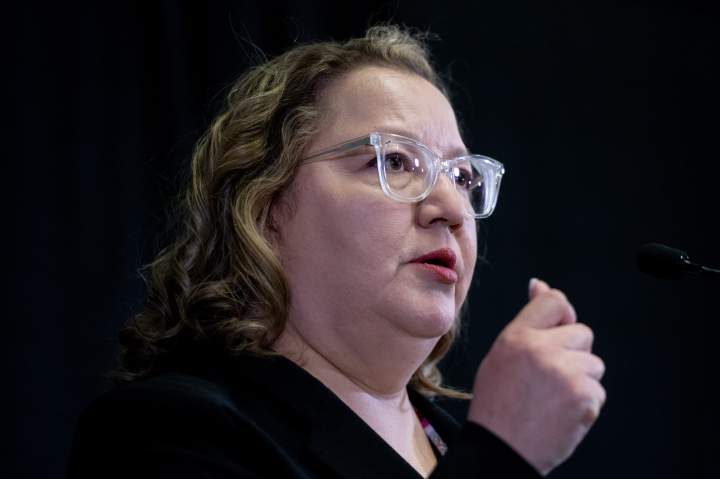
By Michael Wrobel &
Carolyn Jarvis
Global News
Published March 7, 2023
9 min read

When Dawn Flegel took over Sarnia’s children’s aid society in 2012, she went on a listening tour about the child-welfare system that left her feeling appalled.
At roundtables, kids described brutal conditions. Being stigmatized. Feeling isolated.
One kid said he felt like an inmate in his group home and that he would rather be in jail.
“We didn’t hear from a single young person that group homes were good for them,” said Flegel, executive director of the Sarnia-Lambton Children’s Aid Society (CAS) in southwestern Ontario.
Sweeping changes were needed, she resolved, and she made them.
In 2015, Flegel and her colleagues created an ambitious plan called “Chasing Zero” – zero group homes, zero kids growing up in care.
Until then, Sarnia CAS was admitting kids into the child-welfare system at a young age and bouncing them around placements until they “aged out” at 18. Some of the kids lived in foster homes, while others were in group homes.
Group homes in Ontario are mostly run by for-profit companies. They hire rotating shift workers to look after kids who’ve experienced abuse, have complex mental-health needs or, in some cases, are orphaned.
It’s impossible for kids to find any sense of family or belonging in them.
Under Flegel’s plan, that would no longer be an issue.
Group homes would be eliminated. Kids would no longer spend years in the system.
Instead, her team would prioritize “kinship” placements – keeping kids with relatives or supportive adults they already knew. Foster homes would only be used when that wasn’t an option.
The money saved by not using group homes – roughly $4 million annually – would be moved to prevention and early intervention services meant to keep kids out of the child-welfare system in the first place.
They’d help struggling families by doubling the number of support workers and “providing money, sometimes paying for things like daycare, paying for things like counseling,” Flegel said.
“Children’s aid societies as an institution – we’re not great at parenting and we shouldn’t be parenting.”
A local operator of group homes pushed back, filing a lawsuit against Sarnia CAS when it stopped using its services, claiming breach of contract and damages in the amount of roughly $82,000.
Despite being sued, Flegel was steadfast in her conviction.
By February 2019, they reached their first goal: zero kids in group homes. No child from Sarnia CAS has lived in one since.
The achievement is “unparalleled” in the province, according to Kiaras Gharabaghi, one of Canada’s foremost experts on child welfare.
“(Some smaller agencies) have had periods of time where no young person was living in a group home,” the professor at Toronto Metropolitan University said. “But no one has sustained that for four years, and no one is as determined to continue to sustain it as (Sarnia CAS).”
The number of kids in care has dropped as well.
In a decade, it’s down by nearly half – though not to zero, as Flegel had hoped. There’s more work to be done, she said.
At Sarnia’s youth court, Justice Deborah Austin saw the impact of “Chasing Zero.”
Previously, youth living in two Sarnia-area group homes were “disproportionately” represented on the youth court’s docket. The CAS’s changes stopped criminalizing kids for “social problems,” she said, leading to fewer kids appearing in her courtroom.
A yearlong investigation by Global News found poor conditions at group homes across the province, including properties in states of disrepair, limited food and clothing budgets, extensive use of physical restraints, and allegations that kids were overmedicated.
Former workers from some group homes alleged the companies operating them were more focused on profits than meeting kids’ needs.
“They’re very difficult places to find comfort, to find nurture, to find a sense of safety that goes beyond physical safety,” said Gharabaghi.
Even so, many children’s aid societies across Ontario don’t agree with Flegel’s approach of eliminating group homes altogether.
Global News interviewed the executive directors of several CASs who felt these homes were still needed in exceptional circumstances for youth with “complex needs.”
Many front-line employees at Sarnia CAS held that opinion as well, leading to tension when “Chasing Zero” was introduced.
A research paper by Gharabaghi found that staff members supported the idea of keeping kids with relatives, but felt that group homes could sometimes help stabilize kids with “serious mental health issues.”
They objected to the policy’s absolutism.
Flegel pushed back.
“I fundamentally reject the idea that there is no other option for a young person other than placing them in a group (home),” she said.
The child-welfare system needs to “think more creatively” and find ways to give children the support they need in their own homes, Flegel maintained. When child protection concerns arise, placing them with relatives is the next best option, she said.
Sarnia CAS isn’t the only agency now focusing on kinship placements – there’s been a shift toward them across Ontario.
But it hasn’t always been this way.
A decade ago, risk-averse CAS workers would typically place kids in foster homes they’d pre-screened or government-licensed group homes. Only later would they “work backward” to see if relatives could care for the kids, Flegel said.
Relatives would have to navigate the CAS and the family court system before their kin were placed with them.
“We did not make it easy for extended families to take care of their relatives,” she said.
Stephen and Rebecca Krall’s family may not have been kept together only a few years ago.
In the playroom of their ranch-style home in Petrolia, roughly 25 kilometres southeast of Sarnia, three kids played floor hockey with miniature sticks on a chilly Sunday afternoon. Another three lounged on the couch, one playing a video game while the others watched.
The six kids seemed so comfortable with one another that no one would have ever guessed the two girls in the bunch – Grace and Hope – aren’t Stephen and Rebecca’s biological kids. They’re actually Rebecca’s nieces, though they live here full-time.
The thought that kids like Grace and Hope – aged 4 and 1 – probably would’ve been placed with strangers in the past is heartbreaking for Rebecca.
“(Kids) went to foster care and they’d miss out on everything that they should know, like their family,” she said. “They would miss out on all the birthdays and Christmas and everything. That’s really sad to think about.”
The couple’s home is filled with the love and noise of rambunctious kids, and the Kralls wouldn’t have it any other way.
But juggling six kids isn’t easy. And it isn’t cheap.
When Rebecca took in Hope as a baby, she had to quit her job. She’d just used up her maternity leave after her son’s birth.
Stephen is a boilermaker and an ironworker. He usually works in the oil refineries and petrochemical plants just south of Sarnia, but with the household down to just his income, he’s decided to take a job for the next few months at the Darlington Nuclear Generating Station, 350 kilometres away. It means he’ll be living away from Rebecca and the kids for days or weeks at a time.
“I’m lucky I have a good union job that pays well,” Stephen said. “I couldn’t see how someone on minimum wage could afford to do this.”
Families like the Kralls’ fall under what the province calls “kinship service.” They can get up to $1,000 annually, per child, from the child-welfare system.
Another government program, Ontario Works, gives them $274 per month for the first child they take in, and $224 for each additional one.
That’s far less than the amounts given to foster parents and group-home operators. Foster parents get roughly $900 a month per child, while group homes are paid an average of $9,500 per month.
Many “kinship” caregivers are retired grandparents on fixed incomes. The amount offered to them to care for relatives just isn’t enough, according to experts.
In terms of providing for kinship families, Global News found Ontario to be among the least-generous provinces.
Kinship placements have come at a cost for Sarnia CAS as well.
Kids placed with relatives in kinship service arrangements aren’t considered to formally be “in care” by the government, as children in foster or group homes are. And that impacts a children’s aid society’s bottom line.
The Ontario government funds CASs partly based on the number of kids each agency has taken into care. Because of its focus on prevention and keeping kids with relatives, Sarnia CAS’s budget has declined by $1.2 million over the past decade.
The agency had a deficit last year and faces another this year.
“We’re now at a point where if we have to balance our budget, we have to start undoing the very things that led us to the good outcomes that we have seen,” Flegel said.
“It’s not a great feeling right now. … We’ve asked for some additional funds to cover the deficit, to recognize the work that’s been done.”
In a statement, Ontario’s Ministry of Children, Community and Social Services said its funding model “provides (children’s aid) societies with full financial flexibility to focus on supporting children in their own homes by working closely with their families and caregivers, rather than bringing them into society care.”
While Flegel agrees her agency has the “flexibility” to use its government funding as it sees fit, she said it’s still receiving “less money overall.”
The province also defended how much funding is given to kinship families, saying “children’s aid societies may choose to provide additional financial support to kinship service caregivers” beyond the $1,000 annually set out in government directives.
The catch is that the government only allows children’s aid societies to offer more funding to these families if they have a budget surplus. And Sarnia CAS doesn’t.
Still, Dawn Flegel is undeterred. Kids fare far better when they’re with family.
When asked what she hopes kids in the system will say now, she answered: “I hope they say, ‘I belong.’ I hope they say, ‘I have a family.’ I hope they say, ‘I have connections.’ I hope they say, ‘I’m doing well in life.’”
— with files from Maggie Feldbloom
If you would like to share your experience working or living in the child welfare system, please reach out to us in the form below.

















Comments